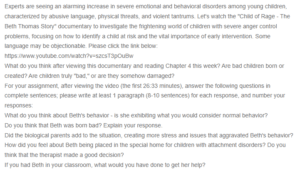Documentary Study on Child of Rage – The Beth Thomas Story
The video depicts a six-and-a-half-year-old girl, Beth, with a reactive attachment disorder. The child expresses her desire to inflict harm on those around her. She hurts her brother at night and wants to stick pins on him and her parents. From her accounts, she wants her brother to die and doesn’t want to be around people, including her parents. Findings from this video reveal that bad children are created, not born. The video also shows that children are not actually “bad” but damaged somehow by an aspect of their environment. Thus, when a child experiences adverse events in their early childhood, they are likely to be damaged.
Q1
Beth is exhibiting a characteristic reactive behavior. Her behavior is not normal. She exhibits behavioral traits inconsistent with other children of the same age. From her accounts, she expresses the desire to hurt those around her. She hurts her brother, often prompting her parents to lock the door to her room at night. She also mentions that she wants her brother to die. These behaviors are unusual for a child her age and demonstrate her trouble loving those around her. They also reveal how easy it is for her to inflict harm on others without remorse or consciousness.
Q2.
I don’t think Beth was born bad. Like other children, Beth was born with no predilection for bad behavior or traits. However, environmental influences in her life shaped her current behaviors. As Han et al. report, human behavior results from their environment and those they interact with. As evident in the case, Beth had a history of early childhood trauma. She didn’t have enough food to eat and was a victim of sexual violence. She endured severe neglect, having lost her mother at the age of one. This may have shaped her current behavior.
Q3.
Beth’s biological parents play a role in her current manifestations. As evident in the video, she endured severe neglect. Her birth mother died when she was very young, denying her maternal love. She is also a victim of sexual abuse. Revelations from her nightmares showed that her birth father may have raped her. Adverse events in early childhood have been implicated in deviant behaviors in later life. These behaviors are particularly pronounced when the perpetrators of these acts are close family members (Nelson et al.). This may be the case with Beth. The adverse events she experienced during her early childhood may be responsible for her current manifestations.
Q5.
The best intervention was to separate Beth from her other family members. Having expressed her intent to cause harm and, in many circumstances, attempted to cause harm to her brother, she needed to be separated from them. Special homes presented a suitable landing point for Beth. She could be monitored closely in such settings to ensure she doesn’t harm anyone. This setting will also offer protection to herself. As evident in the case, the staff in special homes recognizes the complexities presented by these children and the need to monitor them closely. This provides a basis for providing care to them and rehabilitating them. This underpins their suitability in this child’s case.
Q6.
If Beth were in my classroom, I would first recognize her suffering and problems. This will enable me to monitor her closely to prevent her from harming herself and others. I would also provide her with a positive, stimulating environment promoting healing. This will include encouraging her to embrace positive behaviors and caring for them. Caring may facilitate the establishment of stable attachments in the child. By caring for her, she may learn to appreciate the love and affection she may have lacked during her early childhood. Caring may also increase her self-awareness and improve her conscience. This may help in rehabilitating her behavior.
Work Cited
Han, Shuyan, et al. “A Systematic Review of Objective Factors Influencing Behavior in Public Open Spaces.” Frontiers in Public Health, vol. 10, 2022, https://doi.org/10.3389/fpubh.2022.898136.
Nelson, Charles A., et al. “Adversity in Childhood Is Linked to Mental and Physical Health throughout Life.” BMJ, 2020, p. m3048., https://doi.org/10.1136/bmj.m3048.
ORDER A PLAGIARISM-FREE PAPER HERE
We’ll write everything from scratch
Question

Documentary Study on Child of Rage – The Beth Thomas Story
Experts are seeing an alarming increase in severe emotional and behavioral disorders among young children, characterized by abusive language, physical threats, and violent tantrums. Let’s watch the “Child of Rage – The Beth Thomas Story” documentary to investigate the frightening world of children with severe anger control problems, focusing on how to identify a child at risk and the vital importance of early intervention. Some language may be objectionable. Please click the link below:
What do you think after viewing this documentary and reading Chapter 4 this week? Are bad children born or created? Are children truly “bad,” or are they somehow damaged?
For your assignment, after viewing the video (the first 26:33 minutes), answer the following questions in complete sentences; please write at least 1 paragraph (8-10 sentences) for each response, and number your responses:
What do you think about Beth’s behavior – is she exhibiting what you would consider normal behavior?
Do you think that Beth was born bad? Explain your response.
Did the biological parents add to the situation, creating more stress and issues that aggravated Beth’s behavior?
How did you feel about Beth being placed in the special home for children with attachment disorders? Do you think that the therapist made a good decision?
If you had Beth in your classroom, what would you have done to get her help?

